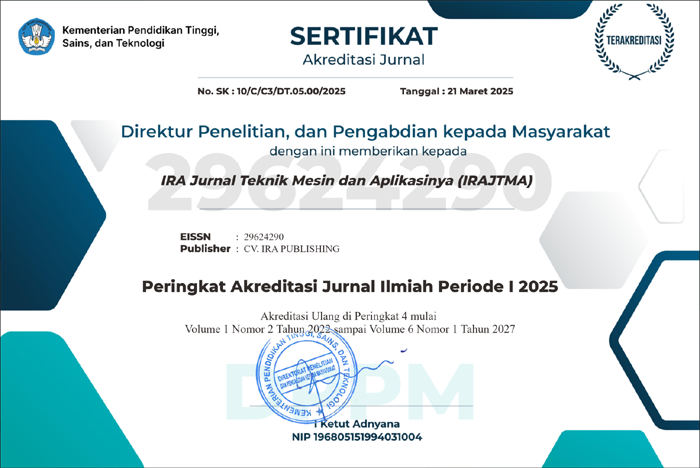Analysis of the Effect of Working Hours on Mental Workload Using the Subjective Workload Assessment Technique Method
DOI:
https://doi.org/10.56862/irajtma.v2i1.29Abstract
This research contains a study of the effect of working hours on mental workload using the Subjective Workload Assessment Technique (SWAT) method. Workload is a consequence of activities given to workers, worker activities can basically be distinguished between physical activities and mental activities. In practice, the workload encountered is a combination of physical workload and mental workload. This study aims to measure mental workload at 10 work stations in the production section at PT Berlian Eka Sakti Tangguh. The SWAT method is a subjective mental workload measurement method based on workers' perceptions. The dimensions are time load, mental effort load and psychological pressure load. The results of the calculation of workload based on SWAT found that the workload category of workers in the production section is at a moderate and high level. The highest workload was experienced at the palm oil storage station (5 workers) at 83.71%. The lowest workload was experienced at the stewing station (3 workers) at 27.36%.
References
Darmadi, Hamid. 2014. Metode Penelitian Pendidikan Sosial. Bandung: Alfabeta.
Hancock, P.A & Meshkati, N. 1988. “Human Mental Workload.” Elsevier Science Publisher B.V : Netherlands.
Harrington, J.M. 2001. “Health Effect of Shift Work and Extended Hours of Work.” Journal of Occupational and Environmental Medicine. University of Birmingham.
Henni, H., Nurina, N., & Abbas, S. F. 2014. Analisis Pengaruh Shift Kerja Terhadap Beban Kerja Mental Pekerja Dengan Menggunakan Metode Swat (Subjective Workload Assessment Technique). JISI: Jurnal Integrasi Sistem Industri, 1(2).
Imatama, Z. 2006. Pengaruh Stres Kerja Terhadap Kinerja Karyawan di Lembaga Pendidikan Perkebunan (LPP) Kampus Medan. Skripsi. Bandung. Universitas Kristen Maranatha. Diakses 23 April 2018.
Kosasih dan Soewedo. 2009. Manajemen Perusahaan Pelayaran. Jakarta: PT. Rajagrafindo Persada.
Luthans, Fred. 1998. Organizational Behavior. Eigt Edition. New York McGrawHill Co.
Maurits L S K dan Widodo I D. 2008. “Faktor dan Penjadwalan Shift Kerja.” Teknoin 13(2): 11-12
McCormick, E. J. 1987. Human Factors in Engineering and Design, 6 th Edition. Singapore: Mc Graw Hill Book Company.
Munandar. 2001. Perilaku Organisasi. Jakarta: Cipta Karya.
Munandar, S. A. 2001. Psikologi Industri dan Organisasi. Depok: Universitas Indonesia
Nurhakiki Nazlia Sunarto. 2018. “Analisis Beban Kerja Karyawan dengan Menggunakan Metode SWAT dan Metode NASA TLX (Studi Kasus di PT. LG Electronics Indonesia).” (1)4
Prabu, M. A. 2010. Manajemen Sumber Daya Manusia Perusahaan. Bandung: Remaja Rosdakarya.
Reid, B. R. 1989. Subjective Workload Assessment Technique : A User’s Guide. Oihi: Aerospace Medical Research Laboratory.
Risma Adelina Simanjuntak. 2010. “Analisis Beban Kerja Mental Dengan Metode Nasa Task Load Index.” Jurusan Teknik Industri, Institut Sains Dan Teknologi AKPRIND Yogyakarta, 3(1).
Robbins, P. Stephen. 2006. Perilaku Organisasi. Edisi Sepuluh. Jakarta: Erlangga
Simanjuntak, R. A. 2010. “Analisis Pengaruh Shift Kerja terhadap Beban Kerja Mental dengan Metode Subjective Workload Assessment Technique (SWAT).” Jurnal Teknologi 3(1): 53-60.
Suud, Mohammad. 2008. Orientasi Kesejahteraan Sosial. Jakarta : Prestasi Pustaka Tarwaka
Sholichul, Lilik Sudiajeng. 2004. Ergonomi Untuk Keselamatan, Kesehatan Kerja dan Produktivitas. Surakarta : UNIBA PRESS.
Sritomo Wignjosoebroto. 2003. Ergonomi Studi Gerak dan Waktu: Teknik Guna Widya, Surabaya.
Downloads
Published
How to Cite
Issue
Section
License
Copyright (c) 2023 IRA Jurnal Teknik Mesin dan Aplikasinya (IRAJTMA)

This work is licensed under a Creative Commons Attribution-ShareAlike 4.0 International License.

















